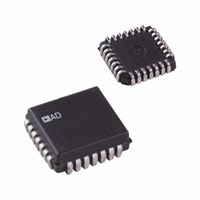AD7569KP Analog Devices Inc, AD7569KP Datasheet - Page 17

AD7569KP
Manufacturer Part Number
AD7569KP
Description
IC I/O PORT 8BIT ANLG 28-PLCC
Manufacturer
Analog Devices Inc
Series
LC²MOSr
Datasheet
1.AD7569JRZ.pdf
(20 pages)
Specifications of AD7569KP
Rohs Status
RoHS non-compliant
Applications
Analog I/O
Interface
Bus
Voltage - Supply
4.75 V ~ 5.25 V
Package / Case
28-LCC (J-Lead)
Mounting Type
Surface Mount
Converter Type
ADC/DAC
Resolution
8b
Number Of Dac's
Single
Data Rate
0.5MSPS
Digital Interface Type
Parallel
Pin Count
28
Package Type
PLCC
Lead Free Status / Rohs Status
Not Compliant
PEAK DETECTION—AD7569
The circuit of Figure 25 shows a peak-reading A/D converter,
which is useful in such applications as monitoring flow rates,
temperature, pressure, etc. The circuit ensures that a peak will
not be missed while at the same time does not require the mi-
croprocessor to frequently monitor the data. The peak value is
stored in the A/D converter and can be read at any time.
The gain on the AD524 is adjusted to yield a 0 V to +2.5 V out-
put. When the input signal exceeds the current stored value, the
output of the TL311 goes low, triggering the Q output of the
74121. This low-going pulse starts a conversion on the AD7569
ADC, and at the end of conversion latches the result into the
DAC. This pulse must be at least 120 ns greater than the con-
version time of the ADC. The Q output is used to drive the
strobe input of the TL311, resetting the TL311 output high in
readiness for another conversion.
The additional gates on the RD and WR inputs are to allow the
data to be read by the microprocessor while at the same time
reads the data. It may be necessary to monitor the AD7569
BUSY line to ensure that a processor READ is not attempted
while the AD7569 is in the middle of a conversion. The READ
pulse width from the processor must be less than 1 s to ensure
correct data is read from the ADC. A low-going pulse on the
RESET line resets the DAC output to 0 V and starts a new “peak-
detection” period. This RESET pulse must also be less than 1 s.
DISK DRIVE APPLICATION—AD7669
Closed-Loop Microstepping
Microstepping is a popular technique in low density disk drives
(both floppy and hard disk) that allows higher positional resolu-
tion of the disk drive head over that obtainable from a full- step
driven stepper motor. Typically, a two-phase stepper motor has
its phase currents driven with a sine-cosine relationship. These
cosinusoidal signals are generated by two DACs driven with the
appropriate data. The resolution of the DACs determines the
number of microsteps into which each full step can be divided.
For example, with a 1.8 full-step motor and a 4-bit DAC, a
microstep size of 0.11 (1.8 /(2
The microstepping technique improves the positioning resolu-
tion possible in any control application; however, the positional
accuracy can be significantly worse than that offered by the
original full-step accuracy specification due to load torque effects.
To ensure that the increased resolution is usable, it is necessary
to use a closed-loop system where the position of the disk drive
REV. B
ensuring that the DAC is not updated when the microprocessor
n
)) is obtainable.
Figure 25. Peak-Reading A/D Converter
–17–
head (or motor) is monitored. The closed-loop system allows an
error between the desired position and the actual position to be
monitored and corrected. The correction is achieved by adjust-
ing the ratio of the phase currents in the motor windings until
the required head position is reached.
The AD7669 is ideally suited for the closed-loop microstepping
technique with its on-chip dual DACs for positioning the disk
drive head, and onboard ADC for monitoring the position of the
head. A generalized circuit for a closed-loop microstepping sys-
tem is shown in Figure 26. The DAC waveforms are shown in
Figure 27, along with the direction information for clockwise ro-
tation supplied by the controller.
The AD7669 is used in the unipolar 0 V to +2.5 V configura-
tion. This allows the circuit of Figure 26 to be completely uni-
polar (+5 V, +12 V supplies); no negative power supplies are
required. The power output stage is a dual H-Bridge device
such as the UDN-2998W from Sprague Electric. The phase
currents in both windings are detected by means of the small
value sense resistors, R
The voltage developed across these resistors is amplified and
compared with the respective DAC output voltage. The com-
parators in turn chop the phase winding current. The ADC
completes the feedback path by converting information from a
suitable transducer for analysis by the controller.
Figure 26. Typical Closed-Loop Microstepping Circuit with
the AD7669
S
A and R
S
B, in series with the windings.
AD7569/AD7669












